The contemporary pizza consumer is pretty well-versed in the language of Neapolitan pizza. We know what a wood-fired brick oven looks like, we appreciate San Marzano tomatoes and we’ve tasted mozzarella di bufala. We even know where to go in Naples for the most historic pizzerias on the planet. But what about other pizza styles that bare Italian pedigrees?
The main alternative to round Neapolitan-influenced pies is without a doubt the Sicilian pizza. For most, the name conjures images of a thick, doughy base smothered with a healthy layer of sauce and a mozzarella blanket. On my recent trip to Sicily, I found some interesting differences between what we call Sicilian pizza and what they call pizza in Sicily.
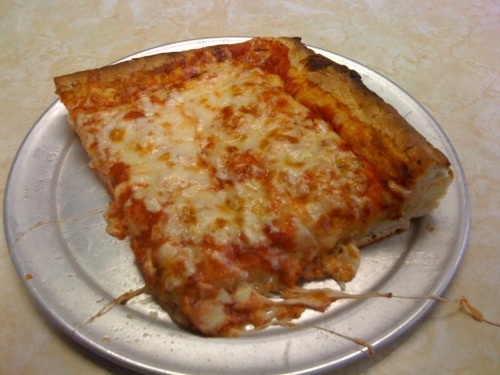
A typical New York Sicilian slice.
Upon arriving in Palermo, one of the first things I did was scout the local pizzerias. I was surprised not to find many and even more shocked at what I noticed next. Contrary to what I expected, the pizza of Sicily is not square. Am I still in Naples? Did I get on the wrong ferry? Nope, the pizza here is round and I’m just going to have to deal with it. Here’s a shot of the first pizza I ate in Sicily.
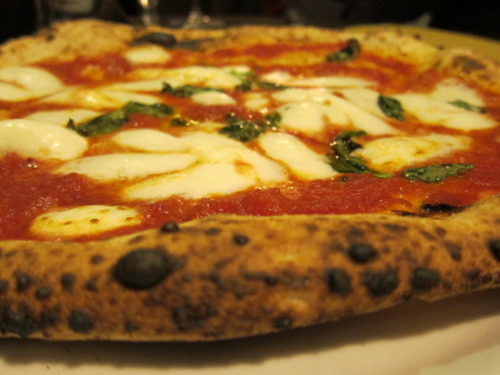
A pizza Margherita at Al Giardino Cucina e Vini in Palermo.
Looks a lot like a wood-fired Neapolitan pizza, right? That’s because it is. (Don’t tell anyone, but I liked this one even more than some of the stuff in Naples.) Sicilians don’t wear their pizza tradition on their sleeves the way Neapolitans do. In fact, they are adamant that real pizza is from Naples.
If we’re going to talk about thick squares of bread, let’s just forget the word pizza altogether. The ancestor of New York’s square pizza goes by a completely different name and, therefore, is not found in Sicilian pizzerias. You’ll have better luck heading to a bakery, or panificio. Bakeries are easy to spot and you’ll instinctively know that they are Sicily’s equivalent to Neapolitan pizzerias based on their frequency alone. Trust me, they are everywhere in Palermo.
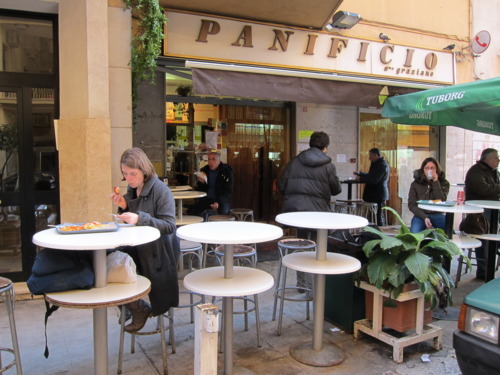
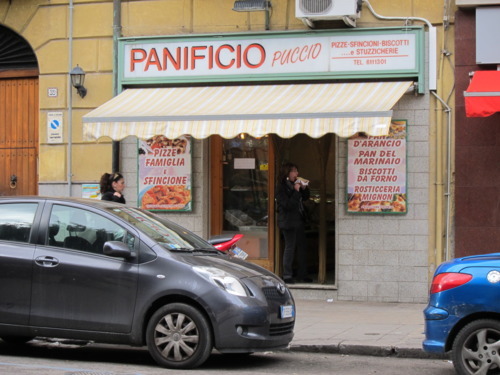
Just head to the counter and ask for sfincione, a square, pan-proofed dough that fries on the base due to a nice amount of oil in the pan. The word itself literally means sponge, which accurately describes the light, airy feel of the base as well as the way the dough absorbs just the right amount of oil on the bottom. Trust me, “spongy” is not an adjective I usually use to describe breads I like but it really does work in this situation.
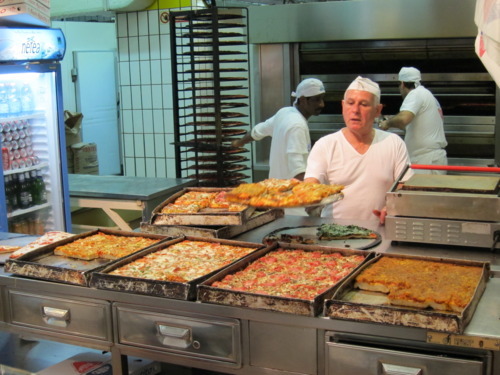
Behind the counter at my favorite sfincione spot of the trip, Panificio Graziano.
The base is exactly like that of a really good New York Sicilian pizza, but the big difference is what’s on top – or rather what isn’t on top. You will not find a trace of mozzarella covering the surface your sfincione. Instead, it’s topped with a thick sauce of diced onion, anchovy and tomato and finished with a dusting of grated hard cheese and bread crumbs.
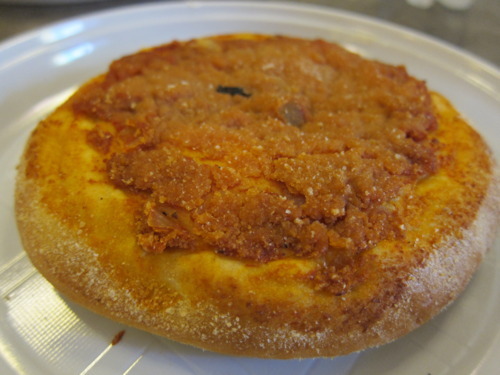
Sfincione at the oldest purveyor in Palermo, Antica Focacceria S. Francesco
Why no mozzarella? Sicily’s milk-producing population consists mainly of sheep and goats, leaving cows in the #3 spot. There’s a good amount of cows’ milk cheese being produced in Sicily, the bulk of it has historically been destined for trade. Fresh cheeses like mozzarella and ricotta won’t be much good for an exporter because of their short shelf life. Hard cheeses have always been more profitable because they are better suited for travel. Therefore, mozzarella didn’t catch on as part of the sfincione formula, which deals more with cheap goods. Anchovy, onion and garlic are easily found locally. To this day Sicily is a major source of tomato production. A panificio’s stale bread becomes the bread crumbs mixed with a touch of grated hard cheese to finish off the dish. There you have it – sfincione.
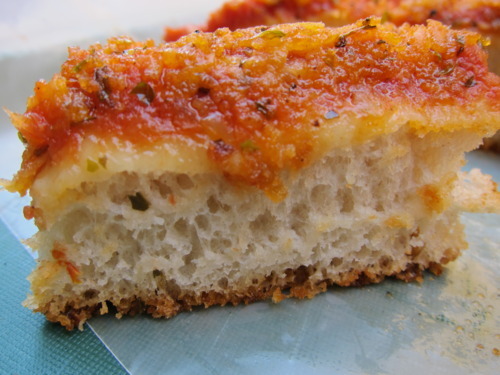
This is a slice of the sfincione all the way on the right side of the above photo.
So how did this saucy snack become so cheesy in New York? The first step is simple and you can find it in old Italian bakeries that had access to inexpensive mozzarella thanks to New York State’s dairy cow industry in the early 20th century. With the close interaction between Sicilian and Neapolitan immigrants in New York’s many Little Italies, the word pizza started being used as a blanket term for anything bready with something baked on top of it. You can find solid bakery pizza at old Italian bread shops like Parisi Bakery on Elizabeth Street in NYC or Dom’s in Hoboken, NJ. These bakers don’t call themselves pizzaioli, the are simply bakers who add toppings to their leftover dough for a bit of extra profit. So the Sicilian pizza of New York is really a combination of the topped bread products of Naples and Sicily.
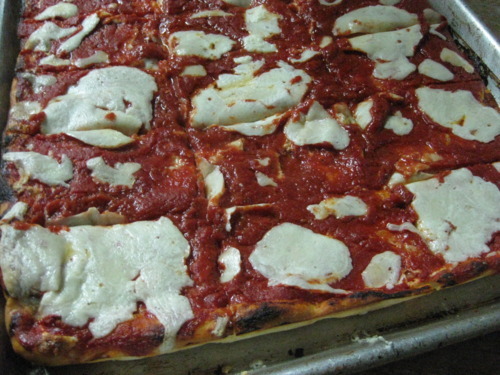
Bakery pizza at Parisi on Elizabeth St in Manhattan.
There are a few pizzerias in NYC that do something similar to traditional sfincione. L&B Spumoni Gardens has a saucy square dusted with pecorino and a secret slice of mozzarella to buffer the sauce from the dough. NY Pizza Suprema has something very similar in look with a more dynamic base. I actually found a pizza topped with bread crumbs instead of cheese at Two Boots! The bread crumbs replace cheese as a binding agent and it tastes really good. But the only pizzeria I have come across that offers a true-blue slice of Sicilian sfincione is Famous Ben’s of Soho – but they don’t call it sfincione. They don’t even call it Sicilian. Just look in the bottom shelf of the glass display case and you’ll see it clearly marked: Palermo.
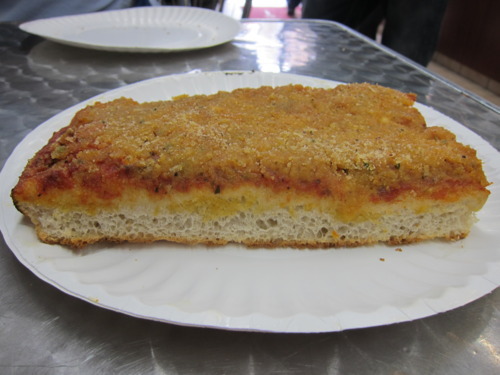
Palermo slice at Ben’s on Spring Street, Manhattan
So check out the Palermo slice at Famous Ben’s if you want to taste the direct ancestor of New York’s Sicilian pizza. It’s one of my new favorites and really offers an alternative to the pillowy cheese-laden squares found at most corner pizzerias. Just be careful, you might quit your job and book a direct flight to Palermo.

